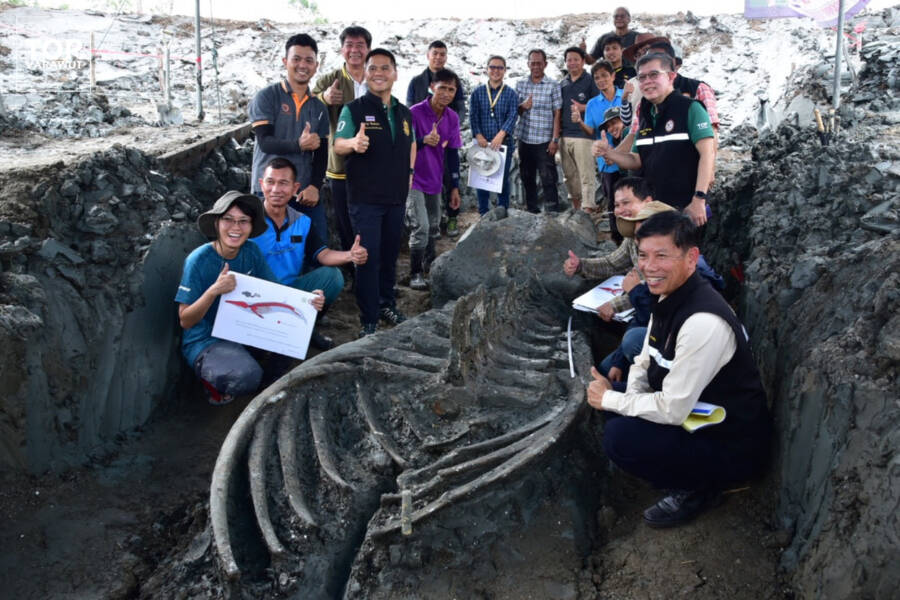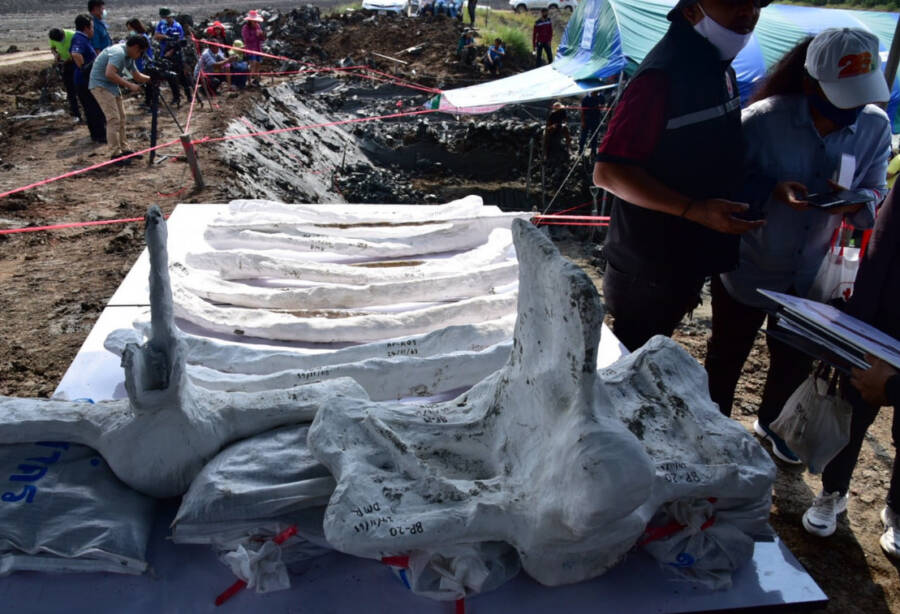The fossilized remains of a Bryde's whale were found near Bangkok, seven miles inland from the shore.

FacebookThe skeleton is estimated to be between 3,000 and 5,000 years old.
Scientists in Thailand have discovered the fossilized remains of a Bryde’s whale. The skeleton was not only remarkably well preserved, but nearly 40 feet long — and potentially as old as 5,000 years. Even more intriguing, the gargantuan specimen was found over seven miles inland.
According to The Guardian, the find was made west of Bangkok in Samut Sakhon. Researchers have thus far excavated 80 percent of the remains and identified 19 complete vertebrae, five ribs, one shoulder blade, and fins. While the animal’s 39-foot length is impressive, its nine-foot-long skull is virtually unbelievable.
For Marcus Chua of the National University of Singapore, the most exciting part is what the find tells us about our prehistoric landscape.
Until now, only marine deposits of small fossilized shells or crabs had been found inland in this area. It wasn’t clear whether those were signs of a sea-level change or if they’d been moved by humans. The newly-discovered whale remains most likely indicate a change in the landscape.
Chua explained that the find adds unprecedented evidence of “relatively large sea level changes around 6,000 years to 3,000 years in the Gulf of Thailand, where the shoreline was up to tens of kilometers inland of the present coast.” According to the BBC, he called the remains “a rare find.”

FacebookResearchers have excavated 80 percent of the specimen, including 19 complete vertebrae, five ribs, one shoulder blade, and fins.
While the bones have yet to be carbon dated, researchers are highly confident this Bryde’s whale specimen is at least 3,000 years old, and could be as old as 5,000. These mammals still have a presence in Thailand’s waters, and have become a protected species in recent years due to threats from tourism to fishing equipment.
Today Bryde’s whales feed on schooling fish like anchovies, and prefer waters warmer than 61 degrees Fahrenheit. But when it comes to how these animals evolved, much is left to learn.
“There are few whale subfossils in Asia,” explained Chua, adding that there are even fewer “in such good condition” as the skeleton discovered in Samut Sakhon. Publicly shared by Thailand’s environment minister Varawut Silpa-archa, the initial images clarify just how well-preserved these bones really are.
Of course, the most entrancing aspect of the find is what it can do to our understanding of the planetary changes that occurred several millennia ago.

FacebookThe exact age, yielded by carbon dating, is expected to be announced this month.
“A large subfossil whale dated thousands of years ago near Bangkok would provide strong evidence of where the sea was during that time,” Chua said.
The domino effect of what this discovery could illuminate seemingly never ceases. The bones offer countless clues regarding the animal’s evolution, what our planet looked like while the specimen was alive — and what that can teach us about our current climate crisis.
“This could certainly bring attention to the issue, and show how and where low-lying areas could be inundated by the sea when that happens,” said Chua.
The find was further bolstered by well-preserved shark teeth and shells that were discovered among the specimen’s fossilized remains. These are expected to teach experts even more about the animal and other marine life that once lived alongside it.

FacebookThe find could shed unprecedented light on prehistoric sea levels in the region.
“Scientists could also study the deposits found at the same level as the whale to reconstruct the biological communities present during that time, and compare them to present day systems,” explained Chua. “So this find provides a window into the past once the skeleton has been dated.”
Fortunately, that latter part of the process is expected to conclude this very month. Chua said that the skeleton will provide experts like him with the “paleological and geological conditions at that time, including sea level estimation, types of sediment, and the contemporary biological communities at that time.”
Chua went on to posit that regional sea levels were possibly up to 12 feet higher back then, amidst highly active tectonic activity. In that sense, there’s really no telling just how much there is to learn here — from what might look like just an old pile of bones.
After learning about the 5,000-year-old whale skeleton discovered in Thailand, read about the headless skeleton of a man trying to flee the Vesuvius eruption that was found at Pompeii. Then, learn about scientists extracting liquid blood and urine from a perfectly preserved 42,000-year-old foal found in Siberia.




